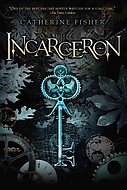Fisher, Catherine. Incarceron. New York: Dial Books - Penguin Group (USA) Inc., 2010. Print. Incarceron 1.
[Book cover credit: librarything.com/work/2998395]
Awards:
Cybils Finalist - Young Adult Fantasy and Science Fiction (2007)
Booktalk:
Finn lives in an vast and inescapable prison. All the unwanted riff-raff of society, the murders, thieves, predators, and other criminals, were once permanently locked away. This prison was supposed to be a paradise where the lowest of society could start over and make things right. But things did not work out as planned. The prison, Incarceron, is a sentient hell-hole where fear, treachery, and hunger rein. And its boundaries have been breached. The prisoners live on the hope left by the legends of Sapphique, a man who is said to have escaped, and Finn, who is thought to have been born of the prison rather than of its prisoners, remembers bits and pieces of a life Outside. With the help of a Sapient, a learned man, he hopes to escape back to the life he thinks he remembers. He remembers the stars.
The world Claudia lives in is based on some fond remembering of the Victorian Era. Everything has been altered to artificially represent this bygone and romanticized time when things were simpler, safer, and more ordered, at least from the point of view of the rich. Everyone, privileged or not, is left chaffing in a world that society has long since outgrown. But like most things in her world, underneath her image, Claudia is decidedly non-Era. She's smart, educated, and wants to know more than she's allowed. As she hurtles towards her wedding to the heir of the throne, she snoops on her father, the Warden of Incarceron. And she finds a key.
Review:
I devoured this book. Twice. The pacing, the storyline, the characters, it all fell into place for me. A lot of the time I think that two simultaneous story lines (as opposed to alternating viewpoints of the same action) make it easy for either or both stories to get away with being a bit under-developed. That's not the case here. Both Finn and Claudia's stories are complex, and the points where they come together are intense. The difference between Claudia's life and Finn's is so stark. Claudia and Finn's disbelief at discovering the other (and realizing how the other must live) is genuine. It also allows for a lot of explanation without a lot of info-dumping. And Fisher uses the alternating viewpoints to create a million mini-cliffhangers throughout the text.
Finn's whole storyline is so urgent. His only certainty is that whatever unknown is around the corner is probably life-threatening. He can't even be sure that his memories of Outside, which come to him during seizures, are real or really his. But Finn is surrounded by friends, or at least by people who need him, like his oathbrother Keiro. Finn and Keiro's relationship is one of my favorite parts of his world. It's complicated and not always all that honest, but they clearly care about each other a lot. And even though their circumstances are over-the-top horrible, they manage to maintain a normal-ish friendship: the kind where a searing punch to the gut can mean "I forgive you."
The society that Claudia lives in is based on the Victorian Era, but this is no revisionist history. The people who put Protocol and Era in place are trying to recreate, not re-remember, that time. They aren't creating an idealized version so much as trying to return to the way things were. Exactly as they were: no technology, widespread healthcare, or women in pants. No indoor plumbing. But in reality they should be much more advanced in all of these areas than we are now. Because of this, the spread between the haves and the have-nots, already extreme in Victorian times, is even more obscene. The have-nots must live like their 19th century counterparts; they don't have the means to change anything. People like Claudia, on the other hand, can use a myriad of technologies to make their lives easier ranging from washing machines for their fine silks to laser skinwands for their wrinkles. They just have to look like they're living within Protocol; they have to make a pretense of not wanting to get caught. Even though most of the heart-pounding action happens inside Incarceron, it's Claudia's world that fascinated me. Hopefully the next book, Sapphique (which I'll review next week), will delve deeper into the technology (and lack thereof) and culture of her world.
Incarceron is deeper and more complicated than I expected (and less steampunk-y than the cover would suggest). I highly recommend it!
Also, Incarceron is already being developed as a movie (2013 projected release) and the sequel is coming out at the end of this month.
Book source: I bought it.

2 comments:
I also reviewed this book and its sequel - you can find my review here. I loved it but the sequel, unfortunately fell a bit short of my expectations. I quite agree - it is not a real steampunk but close.
anachronist - I'm about to review the sequel. I don't think it measured up to the first one either. :( I loved Incarceron though!
Post a Comment